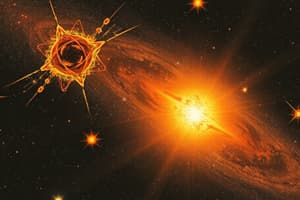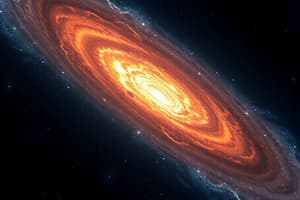Podcast
Questions and Answers
What is the defining characteristic of F-type stars according to the text?
What is the defining characteristic of F-type stars according to the text?
- They have the coolest surface temperatures.
- They are the smallest and densest of all star classes.
- They are typically found in binary systems.
- They have surface temperatures between 6,000 to 7,000 Kelvin. (correct)
During which phase of a star's life does nuclear fusion in the core generate energy?
During which phase of a star's life does nuclear fusion in the core generate energy?
- Protostar phase
- Main sequence phase (correct)
- White dwarf phase
- Red giant phase
What type of star is known for being the coolest in the classification?
What type of star is known for being the coolest in the classification?
- K-type stars
- F-type stars
- G-type stars
- M-type stars (correct)
When does a star become a white dwarf?
When does a star become a white dwarf?
Which type of star is often stable, long-lived, and similar to the Sun in terms of temperature, composition, and size?
Which type of star is often stable, long-lived, and similar to the Sun in terms of temperature, composition, and size?
What happens to a star if it was very massive according to the text?
What happens to a star if it was very massive according to the text?
Which of the following statements about O-type stars is correct?
Which of the following statements about O-type stars is correct?
What is the approximate surface temperature range of B-type stars?
What is the approximate surface temperature range of B-type stars?
Which type of stars are considered to be the smallest and least massive among the types mentioned?
Which type of stars are considered to be the smallest and least massive among the types mentioned?
What is the approximate surface temperature range of A-type stars?
What is the approximate surface temperature range of A-type stars?
Which of the following statements about stars is correct?
Which of the following statements about stars is correct?
What is the primary process through which stars produce light and heat?
What is the primary process through which stars produce light and heat?
Flashcards are hidden until you start studying
Study Notes
Stars are celestial bodies composed of plasma interwoven with magnetic fields. They produce light and heat from nuclear reactions occurring within their cores. Stars are classified into different types based on their spectral characteristics, which correspond to their core temperature and composition. In this semester one physics article, we will discuss the different types of stars, their lifecycles, and how they produce light through nuclear fusion.
Types of Stars
Stars are classified into seven main categories based on their temperature, size, and luminosity. These classifications range from O to M, with O being the most massive and hottest type, and M being the least massive and coolest type. Here is a list of each classification along with its corresponding properties:
- O-type stars: These stars have surface temperatures between 28,000 and 55,000 Kelvin, making them among the hottest known stars. They also possess strong winds and high mass loss rates.
- B-type stars: With surface temperatures ranging from 10,000 to 28,000 Kelvin, these stars exhibit blue or white spectral colors due to their relatively hot surfaces. They are slightly less massive than O-type stars but still lose mass rapidly.
- A-type stars: These stars have a surface temperature of about 7,000 to 10,000 Kelvin, which gives them a white appearance in our sky. A-stars are considerably smaller and less massive than O- and B-stars, and they do not lose mass nearly as quickly.
- F-type stars: With surface temperatures ranging from 6,000 to 7,000 Kelvin, these yellow dwarf stars are similar to the Sun in terms of temperature, composition, and size. They are stable and long-lived, representing over 90% of all star systems detected so far.
- G-type stars: Also known as yellow dwarfs, these stars have surface temperatures between 5,700 and 6,000 Kelvin. Like F-type stars, G-type stars are stable and long-lived.
- K-type stars: These orange or red dwarf stars have surface temperatures ranging from 4,000 to 5,700 Kelvin. As the smallest and densest of all star classes, K-type stars are often found in binary systems and can live for trillions of years.
- M-type stars: With surface temperatures below 4,000 Kelvin, M-type stars are the coolest in the classification. These red dwarfs are typically much smaller and have lower luminosity than other types.
Star Lifecycles
Stars have a lifecycle that begins with their formation and ends with their death. This process is governed by the star's mass and stage of evolution. Here are the different stages of a star's lifecycle:
- Protostar phase: A protostar is a cloud of gas and dust that is collapsing under its own gravity. As the cloud collapses, it begins to form a central core, which eventually ignites nuclear fusion and becomes a star.
- Main sequence phase: This is the longest phase of a star's life, during which it generates energy through nuclear fusion in its core. The star's temperature and luminosity remain relatively constant during this phase.
- Red giant phase: As a star ages, it begins to use up its nuclear fuel. As a result, it expands and cools, becoming a red giant. The star's outer layers expand and eventually envelop its planetary system, potentially leading to the formation of a planetary nebula.
- Planetary nebula phase: After the red giant phase, the star's core collapses and contracts, causing a burst of radiation and the ejection of its outer layers into space. This forms a planetary nebula, a beautiful cosmic cloud of gas and dust.
- White dwarf phase: Once a star has lost its outer layers, its core collapses further until it becomes a white dwarf. White dwarfs slowly cool down over billions of years, eventually becoming black dwarfs.
- Black hole formation: If the star was very massive, its core collapses under extreme gravitational forces, forming a black hole. Black holes are incredibly dense objects with gravity so strong that nothing, not even light, can escape them.
How Stars Produce Light Through Nuclear Fusion
Stars produce light through nuclear fusion, a process where atomic nuclei combine to form heavier elements and release energy. In stars like our Sun, hydrogen atoms are the primary fuel source for this process. The fusion reaction occurs when two hydrogen nuclei combine to form helium, releasing a large amount of energy in the process.
This energy is produced in the star's core, where temperatures and pressures are extremely high due to the star's immense mass. This heat causes the hydrogen to break apart, allowing the positively charged protons to overcome their natural repulsion and combine with each other. Once two protons have combined, they form a neutron, creating helium.
However, since the neutrons have no electric charge, they are attracted to electrons in nearby atoms. These attractive forces cause the electrons to fly off, leaving behind a helium nucleus made up of one proton and one neutron. This process releases a significant amount of energy, which is then radiated away from the star in the form of visible light.
In conclusion, stars play a fundamental role in the universe, providing us with light, warmth, and life-sustaining elements through nuclear fusion. Understanding the different types of stars, their lifecycles, and how they produce light can help us better appreciate the wonders of the cosmos and our place within it.
Studying That Suits You
Use AI to generate personalized quizzes and flashcards to suit your learning preferences.




